Validation of Novel Stride Length Model-Based Approaches to Estimate Distance Covered Based on Acceleration and Pressure Data During Walking
Abstract
1. Introduction
2. Materials and Methods
2.1. Data Collection
2.2. Foot-Worn Sensors
2.3. Phase Segmentation of Signal
2.4. Stride Length Model-Based Algorithms
| Algorithm 1: Model-based algorithm using director coefficients cj of acceleration data for stride length |
| Input: Acceleration A3 × ns(t) = [Asx, Asy, Asz]T, Ns stride count for the insole, and position P3 × nm (t) = [Pmx, Pmy, Pmz]T for the reference model Output: Averaged stride length (L) 1: Determine the coefficients of the model position Pmx(t) in Equation (3) 2: Calculate velocity Vmx (t) in Equation (4) 3: Calculate acceleration Amx (t) of model in Equation (5) 4: For number of strides (Ns) do 5: Segmentation, centering, and determination of the straight line of Asxn(t) of insole 6: Determine the ratio of director coefficients (R) of the accelerations of model and insole 7: Calculate mean of this ratio (R) 8: End for 9: Return R 10: Calculate average stride length (L) by multiplying Px and R |
| Algorithm 2: Model-based algorithm using the DTW for stride length |
| Input: Acceleration A3 × nm (t) = [Amx, Amy, Amz]T, Ns stride count for the insole, and position P3 × nm (t) = [Pmx, Pmy, Pmz]T for the reference model Output: Averaged stride length (L), 1: Determine the coefficients of the model position Pmx(t) in Equation (3) 2: Calculate velocity Vmx(t) of model in Equation (4) 3: Calculate acceleration Amx(t) of model in Equation (5) 4: Determine coefficient (S) in Equation (6) 5: For number of strides do 6: Segmentation, centering, and determination of the straight line of Asxn(t) 7: Calculate dn(t) in Equation (7) 8: Calculate E in Equation (8) 9: End for 10: Return E 11: Determine L by multiplying Px and E |
2.5. Statistical Analysis
3. Results
4. Discussion
5. Conclusions
Author Contributions
Funding
Institutional Review Board Statement
Informed Consent Statement
Data Availability Statement
Acknowledgments
Conflicts of Interest
References
- Helmrich, S.P.; Ragland, D.R.; Leung, R.W.; Paffenbarger, R.S., Jr. Physical activity and reduced occurrence of non-insulin-dependent diabetes mellitus. N. Engl. J. Med. 1991, 325, 147–152. [Google Scholar] [CrossRef]
- Lee, I.-M.; Paffenbarger, R.S., Jr.; Hsieh, C.-c. Physical activity and risk of developing colorectal cancer among college alumni. JNCI J. Natl. Cancer Inst. 1991, 83, 1324–1329. [Google Scholar] [CrossRef] [PubMed]
- Paffenbarger, R.S., Jr.; Hyde, R.T.; Wing, A.L.; Lee, I.-M.; Jung, D.L.; Kampert, J.B. The association of changes in physical-activity level and other lifestyle characteristics with mortality among men. N. Engl. J. Med. 1993, 328, 538–545. [Google Scholar] [CrossRef] [PubMed]
- Sesso, H.D.; Paffenbarger, R.S., Jr.; Lee, I.-M. Physical activity and coronary heart disease in men: The Harvard Alumni Health Study. Circulation 2000, 102, 975–980. [Google Scholar] [CrossRef] [PubMed]
- Simpson, M.E.; Serdula, M.; Galuska, D.A.; Gillespie, C.; Donehoo, R.; Macera, C.; Mack, K. Walking trends among US adults: The behavioral risk factor surveillance system, 1987–2000. Am. J. Prev. Med. 2003, 25, 95–100. [Google Scholar] [CrossRef]
- Lee, I.-M.; Buchner, D.M. The importance of walking to public health. Med. Sci. Sports Exerc. 2008, 40, S512–S518. [Google Scholar] [CrossRef] [PubMed]
- Cimolin, V.; Galli, M. Summary measures for clinical gait analysis: A literature review. Gait Posture 2014, 39, 1005–1010. [Google Scholar] [CrossRef]
- Opasich, C.; Pinna, G.; Mazza, A.; Febo, O.; Riccardi, R.; Riccardi, P.; Capomolla, S.; Forni, G.; Cobelli, F.; Tavazzi, L. Six-minute walking performance in patients with moderate-to-severe heart failure; is it a useful indicator in clinical practice? Eur. Heart J. 2001, 22, 488–496. [Google Scholar] [CrossRef]
- Mariani, B.; Hoskovec, C.; Rochat, S.; Büla, C.; Penders, J.; Aminian, K. 3D gait assessment in young and elderly subjects using foot-worn inertial sensors. J. Biomech. 2010, 43, 2999–3006. [Google Scholar] [CrossRef]
- Zrenner, M.; Gradl, S.; Jensen, U.; Ullrich, M.; Eskofier, B.M. Comparison of different algorithms for calculating velocity and stride length in running using inertial measurement units. Sensors 2018, 18, 4194. [Google Scholar] [CrossRef]
- Sabatini, A.M. Quaternion-based strap-down integration method for applications of inertial sensing to gait analysis. Med. Biol. Eng. Comput. 2005, 43, 94–101. [Google Scholar] [CrossRef]
- Sabatini, A.M.; Martelloni, C.; Scapellato, S.; Cavallo, F. Assessment of walking features from foot inertial sensing. IEEE Trans. Biomed. Eng. 2005, 52, 486–494. [Google Scholar] [CrossRef] [PubMed]
- Ziagkas, E.; Loukovitis, A.; Zekakos, D.X.; Chau, T.D.-P.; Petrelis, A.; Grouios, G. A novel tool for gait analysis: Validation study of the smart insole podosmart®. Sensors 2021, 21, 5972. [Google Scholar] [CrossRef] [PubMed]
- Coutts, A.J.; Duffield, R. Validity and reliability of GPS devices for measuring movement demands of team sports. J. Sci. Med. Sport 2010, 13, 133–135. [Google Scholar] [CrossRef] [PubMed]
- Duffield, R.; Reid, M.; Baker, J.; Spratford, W. Accuracy and reliability of GPS devices for measurement of movement patterns in confined spaces for court-based sports. J. Sci. Med. Sport 2010, 13, 523–525. [Google Scholar] [CrossRef]
- Waldron, M.; Worsfold, P.; Twist, C.; Lamb, K. Concurrent validity and test–retest reliability of a global positioning system (GPS) and timing gates to assess sprint performance variables. J. Sports Sci. 2011, 29, 1613–1619. [Google Scholar] [CrossRef]
- Alvarez, J.C.; González, R.C.; Alvarez, D.; López, A.M.; Rodríguez-Uría, J. Multisensor approach to walking distance estimation with foot inertial sensing. In Proceedings of the 2007 29th Annual International Conference of the IEEE Engineering in Medicine and Biology Society, Lyon, France, 22–26 August 2007; IEEE: New York, NY, USA, 2007; pp. 5719–5722. [Google Scholar]
- Bennett, T.; Jafari, R.; Gans, N. An extended kalman filter to estimate human gait parameters and walking distance. In Proceedings of the 2013 American Control Conference, Washington, DC, USA, 17–19 June 2013; IEEE: New York, NY, USA, 2013; pp. 752–757. [Google Scholar]
- Meng, X.; Zhang, Z.-Q.; Wu, J.-K.; Wong, W.-C.; Yu, H. Self-contained pedestrian tracking during normal walking using an inertial/magnetic sensor module. IEEE Trans. Biomed. Eng. 2013, 61, 892–899. [Google Scholar] [CrossRef]
- Shih, W.-Y.; Chen, L.-Y.; Lan, K.-C. Estimating walking distance with a smart phone. In Proceedings of the 2012 Fifth International Symposium on Parallel Architectures, Algorithms and Programming, Taipei, Taiwan, 17–20 December 2012; IEEE: New York, NY, USA, 2012; pp. 166–171. [Google Scholar]
- Shin, S.; Park, C.; Kim, J.; Hong, H.; Lee, J. Adaptive step length estimation algorithm using low-cost MEMS inertial sensors. In Proceedings of the 2007 IEEE Sensors Applications Symposium, San Diego, CA, USA, 6–8 February 2007; IEEE: New York, NY, USA, 2007; pp. 1–5. [Google Scholar]
- Wang, J.-S.; Lin, C.-W.; Yang, Y.-T.C.; Ho, Y.-J. Walking pattern classification and walking distance estimation algorithms using gait phase information. IEEE Trans. Biomed. Eng. 2012, 59, 2884–2892. [Google Scholar] [CrossRef]
- Wang, Y.; Xu, J.; Xu, X.; Wu, X.; Pottie, G.; Kasier, W. Inertial sensor based motion trajectory visualization and quantitative quality assessment of hemiparetic gait. In Proceedings of the 8th International Conference on Body Area Networks, Boston, MA, USA, 30 September–2 October 2013; pp. 169–172. [Google Scholar]
- Díez, L.E.; Bahillo, A.; Otegui, J.; Otim, T. Step length estimation methods based on inertial sensors: A review. IEEE Sens. J. 2018, 18, 6908–6926. [Google Scholar] [CrossRef]
- Hutabarat, Y.; Owaki, D.; Hayashibe, M. Recent advances in quantitative gait analysis using wearable sensors: A review. IEEE Sens. J. 2021, 21, 26470–26487. [Google Scholar] [CrossRef]
- Vezočnik, M.; Juric, M.B. Average step length estimation models’ evaluation using inertial sensors: A review. IEEE Sens. J. 2018, 19, 396–403. [Google Scholar] [CrossRef]
- Miyazaki, S. Long-term unrestrained measurement of stride length and walking velocity utilizing a piezoelectric gyroscope. IEEE Trans. Biomed. Eng. 1997, 44, 753–759. [Google Scholar] [CrossRef] [PubMed]
- Tjhai, C.; O’Keefe, K. Step-size estimation using fusion of multiple wearable inertial sensors. In Proceedings of the 2017 International Conference on Indoor Positioning and Indoor Navigation (IPIN), Sapporo, Japan, 18–21 September 2017; IEEE: New York, NY, USA, 2017; pp. 1–8. [Google Scholar]
- Kim, J.W.; Jang, H.J.; Hwang, D.-H.; Park, C. A step, stride and heading determination for the pedestrian navigation system. J. Glob. Position. Syst. 2004, 3, 273–279. [Google Scholar] [CrossRef]
- Weinberg, H. Using the ADXL202 in Pedometer and Personal Navigation Applications; Analog Devices: Norwood, MA, USA, 2002; Volume 2, pp. 1–6. [Google Scholar]
- Xia, H.; Zuo, J.; Liu, S.; Qiao, Y. Indoor localization on smartphones using built-in sensors and map constraints. IEEE Trans. Instrum. Meas. 2018, 68, 1189–1198. [Google Scholar] [CrossRef]
- Do, T.-N.; Liu, R.; Yuen, C.; Zhang, M.; Tan, U.-X. Personal dead reckoning using IMU mounted on upper torso and inverted pendulum model. IEEE Sens. J. 2016, 16, 7600–7608. [Google Scholar] [CrossRef]
- Jiang, Y.; Li, Z.; Wang, J. Ptrack: Enhancing the applicability of pedestrian tracking with wearables. IEEE Trans. Mob. Comput. 2018, 18, 431–443. [Google Scholar] [CrossRef]
- Zijlstra, W.; Hof, A.L. Assessment of spatio-temporal gait parameters from trunk accelerations during human walking. Gait Posture 2003, 18, 1–10. [Google Scholar] [CrossRef]
- Bousdar Ahmed, D.; Diaz, E.M.; Garcia Dominguez, J.J. Automatic calibration of the step length model of a pocket INS by means of a foot inertial sensor. Sensors 2020, 20, 2083. [Google Scholar] [CrossRef]
- Martinelli, A.; Gao, H.; Groves, P.D.; Morosi, S. Probabilistic context-aware step length estimation for pedestrian dead reckoning. IEEE Sens. J. 2017, 18, 1600–1611. [Google Scholar] [CrossRef]
- Pham, T.T.; Suh, Y.S. Conditional generative adversarial network-based regression approach for walking distance estimation using waist-mounted inertial sensors. IEEE Trans. Instrum. Meas. 2022, 71, 2510113. [Google Scholar] [CrossRef]
- Wang, A.; Ou, X.; Wang, B. Improved step detection and step length estimation based on pedestrian dead reckoning. In Proceedings of the 2019 IEEE 6th International Symposium on Electromagnetic Compatibility (ISEMC), Nanjing, China, 1–4 November 2019; pp. 1–4. [Google Scholar]
- Suzuki, Y.; Hahn, M.E.; Enomoto, Y. Estimation of foot trajectory and stride length during level ground running using foot-mounted inertial measurement units. Sensors 2022, 22, 7129. [Google Scholar] [CrossRef] [PubMed]
- Peruzzi, A.; Della Croce, U.; Cereatti, A. Estimation of stride length in level walking using an inertial measurement unit attached to the foot: A validation of the zero velocity assumption during stance. J. Biomech. 2011, 44, 1991–1994. [Google Scholar] [CrossRef] [PubMed]
- Skog, I.; Handel, P.; Nilsson, J.-O.; Rantakokko, J. Zero-velocity detection—An algorithm evaluation. IEEE Trans. Biomed. Eng. 2010, 57, 2657–2666. [Google Scholar] [CrossRef] [PubMed]
- Bamberg, S.J.M.; Benbasat, A.Y.; Scarborough, D.M.; Krebs, D.E.; Paradiso, J.A. Gait analysis using a shoe-integrated wireless sensor system. IEEE Trans. Inf. Technol. Biomed. 2008, 12, 413–423. [Google Scholar] [CrossRef]
- Rampp, A.; Barth, J.; Schülein, S.; Gaßmann, K.-G.; Klucken, J.; Eskofier, B.M. Inertial sensor-based stride parameter calculation from gait sequences in geriatric patients. IEEE Trans. Biomed. Eng. 2014, 62, 1089–1097. [Google Scholar] [CrossRef]
- Yang, S.; Mohr, C.; Li, Q. Ambulatory running speed estimation using an inertial sensor. Gait Posture 2011, 34, 462–466. [Google Scholar] [CrossRef]
- Gradl, S.; Zrenner, M.; Schuldhaus, D.; Wirth, M.; Cegielny, T.; Zwick, C.; Eskofier, B.M. Movement speed estimation based on foot acceleration patterns. In Proceedings of the 2018 40th Annual International Conference of the IEEE Engineering in Medicine and Biology Society (EMBC), Honolulu, HI, USA, 18–21 July 2018; IEEE: New York, NY, USA, 2018; pp. 3505–3508. [Google Scholar]
- Díaz, S.; Disdier, S.; Labrador, M.A. Step length and step width estimation using wearable sensors. In Proceedings of the 2018 9th IEEE Annual Ubiquitous Computing, Electronics & Mobile Communication Conference (UEMCON), New York, NY, USA, 8–10 November 2018; IEEE: New York, NY, USA, 2018; pp. 997–1001. [Google Scholar]
- Gu, F.; Khoshelham, K.; Yu, C.; Shang, J. Accurate step length estimation for pedestrian dead reckoning localization using stacked autoencoders. IEEE Trans. Instrum. Meas. 2018, 68, 2705–2713. [Google Scholar] [CrossRef]
- Hannink, J.; Kautz, T.; Pasluosta, C.F.; Barth, J.; Schülein, S.; Gaßmann, K.-G.; Klucken, J.; Eskofier, B.M. Mobile stride length estimation with deep convolutional neural networks. IEEE J. Biomed. Health Inform. 2017, 22, 354–362. [Google Scholar] [CrossRef]
- Klein, I.; Asraf, O. StepNet—Deep learning approaches for step length estimation. IEEE Access 2020, 8, 85706–85713. [Google Scholar] [CrossRef]
- Sui, J.-D.; Chang, T.-S. IMU based deep stride length estimation with self-supervised learning. IEEE Sens. J. 2021, 21, 7380–7387. [Google Scholar] [CrossRef]
- Wang, Q.; Luo, H.; Ye, L.; Men, A.; Zhao, F.; Huang, Y.; Ou, C. Personalized stride-length estimation based on active online learning. IEEE Internet Things J. 2020, 7, 4885–4897. [Google Scholar] [CrossRef]
- Ngueleu, A.-M.; Batcho, C.S.; Otis, M.J.-D. Comparison and validation of pressure and acceleration time-domain waveform models of a smart insole for accurate step count in healthy people. In Proceedings of the 9th International Conference on Bioinformatics Research and Applications, Berlin, Germany, 18–20 September 2022; pp. 129–134. [Google Scholar]
- Schwameder, H.; Andress, M.; Graf, E.; Strutzenberger, G. Validation of an IMU-System (Gait-Up) to identify gait parameters in normal and induced limping walking conditions. In Proceedings of the ISBS-Conference Proceedings Archive, Poitiers, France, 29 June–3 July 2015. [Google Scholar]
- Wang, B.; Rajput, K.S.; Tam, W.-K.; Tung, A.K.; Yang, Z. FreeWalker: A smart insole for longitudinal gait analysis. In Proceedings of the 2015 37th Annual International Conference of the IEEE Engineering in Medicine and Biology Society (EMBC), Milan, Italy, 25–29 August 2015; IEEE: New York, NY, USA, 2015; pp. 3723–3726. [Google Scholar]
- Yeh, Y.-H.; Yan, J.-L.; Gu, M.-X.; Chen, Y.-W.; Lee, T.-S. Frequency-domain analysis for accurate and robust gait cycle time detection with clinical data. In Proceedings of the 2022 44th Annual International Conference of the IEEE Engineering in Medicine & Biology Society (EMBC), Glasgow, UK, 11–15 July 2022; IEEE: New York, NY, USA, 2022; pp. 4200–4204. [Google Scholar]
- Asogwa, C.O.; Nagano, H.; Wang, K.; Begg, R. Using Deep Learning to Predict Minimum Foot–Ground Clearance Event from Toe-Off Kinematics. Sensors 2022, 22, 6960. [Google Scholar] [CrossRef] [PubMed]
- Begg, R.; Best, R.; Dell’Oro, L.; Taylor, S. Minimum foot clearance during walking: Strategies for the minimisation of trip-related falls. Gait Posture 2007, 25, 191–198. [Google Scholar] [CrossRef]
- Lai, D.T.; Taylor, S.B.; Begg, R.K. Prediction of foot clearance parameters as a precursor to forecasting the risk of tripping and falling. Hum. Mov. Sci. 2012, 31, 271–283. [Google Scholar] [CrossRef]
- Ojeda, L.V.; Zaferiou, A.M.; Cain, S.M.; Vitali, R.V.; Davidson, S.P.; Stirling, L.A.; Perkins, N.C. Estimating stair running performance using inertial sensors. Sensors 2017, 17, 2647. [Google Scholar] [CrossRef]
- Moufawad El Achkar, C.; Lenoble-Hoskovec, C.; Paraschiv-Ionescu, A.; Major, K.; Büla, C.; Aminian, K. Physical behavior in older persons during daily life: Insights from instrumented shoes. Sensors 2016, 16, 1225. [Google Scholar] [CrossRef]
- Lin, C.; Chang, P.; Luh, J. Formulation and optimization of cubic polynomial joint trajectories for industrial robots. IEEE Trans. Autom. Control 1983, 28, 1066–1074. [Google Scholar] [CrossRef]
- Giorgino, T. Computing and visualizing dynamic time warping alignments in R: The dtw package. J. Stat. Softw. 2009, 31, 1–24. [Google Scholar] [CrossRef]
- Koo, T.K.; Li, M.Y. A guideline of selecting and reporting intraclass correlation coefficients for reliability research. J. Chiropr. Med. 2016, 15, 155–163. [Google Scholar] [CrossRef]
- Tirosh, O.; Begg, R.; Passmore, E.; Knopp-Steinberg, N. Wearable textile sensor sock for gait analysis. In Proceedings of the 2013 Seventh International Conference on Sensing Technology (ICST), Wellington, New Zealand, 3–5 December 2013; IEEE: New York, NY, USA, 2013; pp. 618–622. [Google Scholar]
- Guo, Y.; Sun, Y.; Luo, H.; Guizani, N. Accurate indoor localization based on crowd sensing. Wirel. Commun. Mob. Comput. 2016, 16, 2852–2868. [Google Scholar] [CrossRef]
- Dalton, A.; Khalil, H.; Busse, M.; Rosser, A.; van Deursen, R.; ÓLaighin, G. Analysis of gait and balance through a single triaxial accelerometer in presymptomatic and symptomatic Huntington’s disease. Gait Posture 2013, 37, 49–54. [Google Scholar] [CrossRef] [PubMed]
- Godfrey, A.; Del Din, S.; Barry, G.; Mathers, J.C.; Rochester, L. Within trial validation and reliability of a single tri-axial accelerometer for gait assessment. In Proceedings of the 2014 36th Annual International Conference of the IEEE Engineering in Medicine and Biology Society, Chicago, IL, USA, 26–30 August 2014; IEEE: New York, NY, USA, 2014; pp. 5892–5895. [Google Scholar]
- Del Din, S.; Godfrey, A.; Rochester, L. Validation of an accelerometer to quantify a comprehensive battery of gait characteristics in healthy older adults and Parkinson’s disease: Toward clinical and at home use. IEEE J. Biomed. Health Inform. 2015, 20, 838–847. [Google Scholar] [CrossRef] [PubMed]
- Truong, P.H.; Lee, J.; Kwon, A.-R.; Jeong, G.-M. Stride counting in human walking and walking distance estimation using insole sensors. Sensors 2016, 16, 823. [Google Scholar] [CrossRef]
- Aminian, K.; Najafi, B.; Büla, C.; Leyvraz, P.-F.; Robert, P. Spatio-temporal parameters of gait measured by an ambulatory system using miniature gyroscopes. J. Biomech. 2002, 35, 689–699. [Google Scholar] [CrossRef]
- González, R.; Alvarez, D.; López, A.; Alvarez, J. Ambulatory estimation of mean step length during unconstrained walking by means of COG accelerometry. Comput. Methods Biomech. Biomed. Eng. 2009, 12, 721–726. [Google Scholar] [CrossRef]
- Lueken, M.; Loeser, J.; Weber, N.; Bollheimer, C.; Leonhardt, S.; Ngo, C. Model-based step length estimation using a pendant-integrated mobility sensor. IEEE Trans. Neural Syst. Rehabil. Eng. 2021, 29, 2655–2665. [Google Scholar] [CrossRef]
- Zijlstra, W.; Hof, A.L. Displacement of the pelvis during human walking: Experimental data and model predictions. Gait Posture 1997, 6, 249–262. [Google Scholar] [CrossRef]
- Fulk, G.D.; Edgar, S.R.; Bierwirth, R.; Hart, P.; Lopez-Meyer, P.; Sazonov, E. Identifying activity levels and steps of people with stroke using a novel shoe-based sensor. J. Neurol. Phys. Ther. 2012, 36, 100–107. [Google Scholar] [CrossRef]
- Lin, F.; Wang, A.; Song, C.; Xu, W.; Li, Z.; Li, Q. A comparative study of smart insole on real-world step count. In Proceedings of the 2015 IEEE Signal Processing in Medicine and Biology Symposium (SPMB), Philadelphia, PA, USA, 12 December 2015; IEEE: New York, NY, USA, 2015; pp. 1–6. [Google Scholar]
- Piau, A.; Charlon, Y.; Campo, E.; Vellas, B.; Nourhashemi, F. A smart insole to promote healthy aging for frail elderly individuals: Specifications, design, and preliminary results. JMIR Rehabil. Assist. Technol. 2015, 2, e4084. [Google Scholar] [CrossRef]
- Rodriguez, A.; Balsamo, D.; Luo, Z.; Beeby, S.P.; Merrett, G.V.; Weddell, A.S. Intermittently-powered energy harvesting step counter for fitness tracking. In Proceedings of the 2017 IEEE Sensors Applications Symposium (SAS), Glassboro, NJ, USA, 13–15 March 2017; IEEE: New York, NY, USA, 2017; pp. 1–6. [Google Scholar]
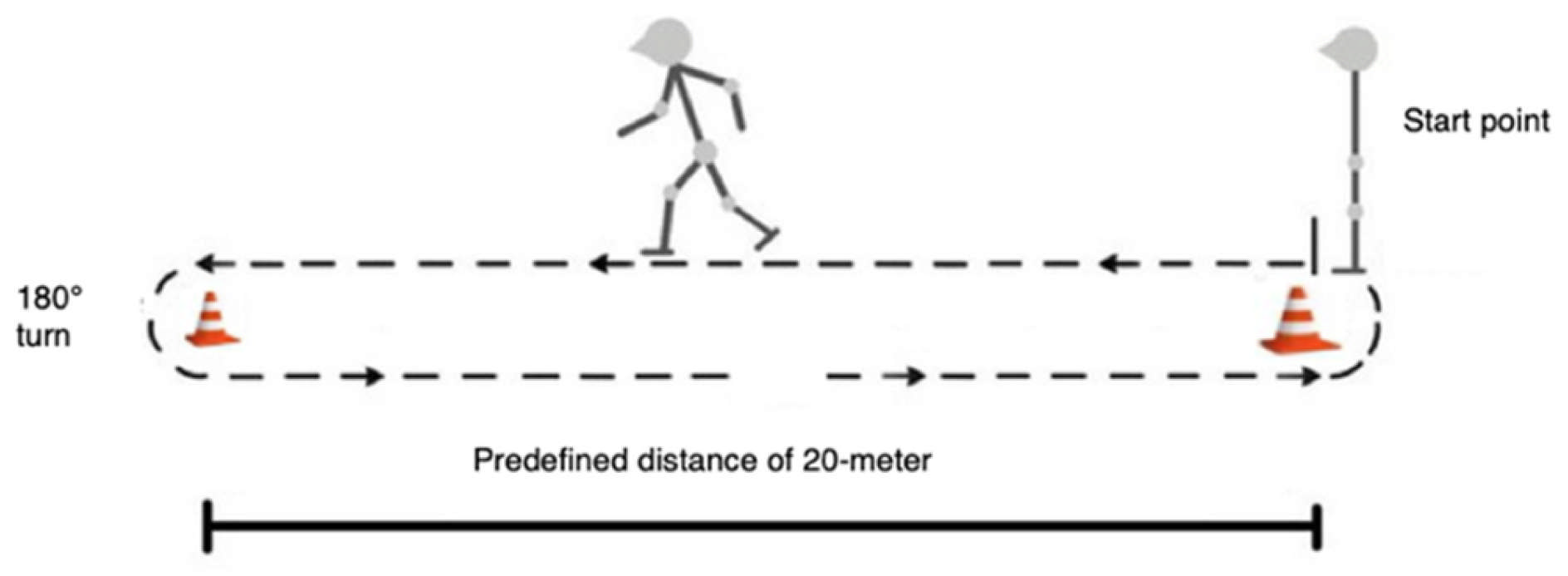
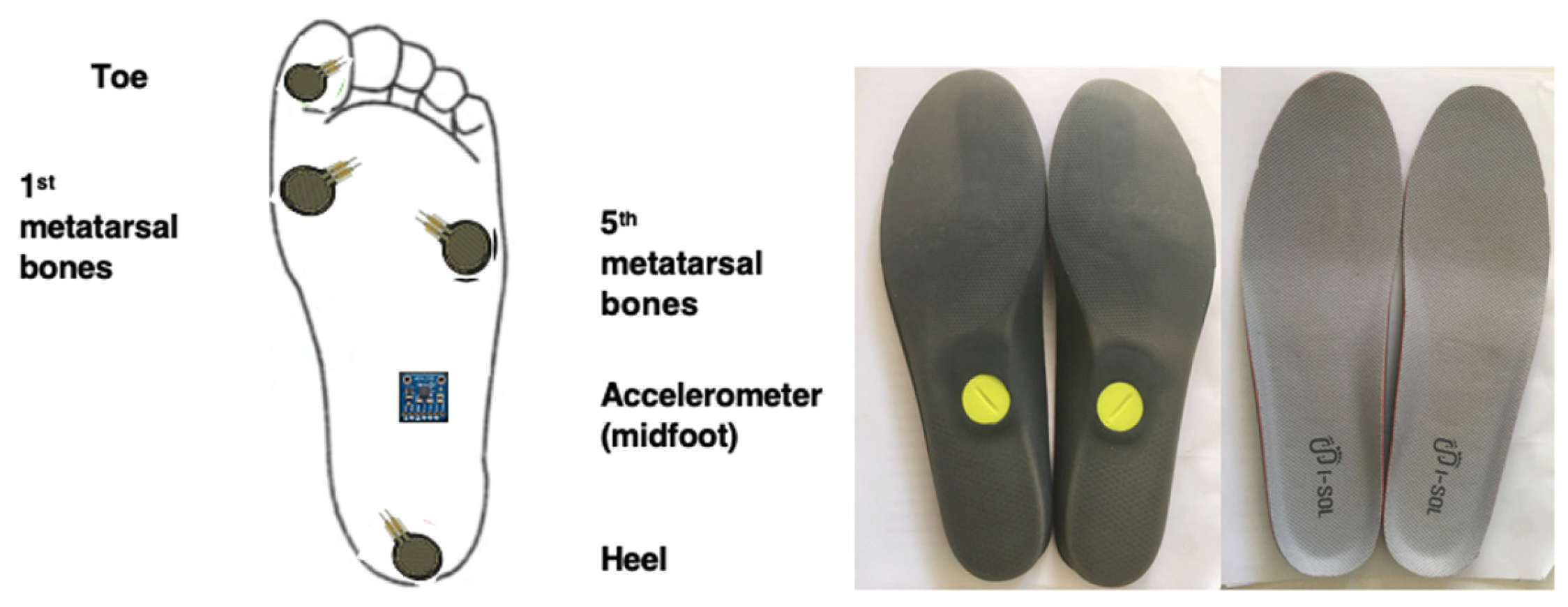
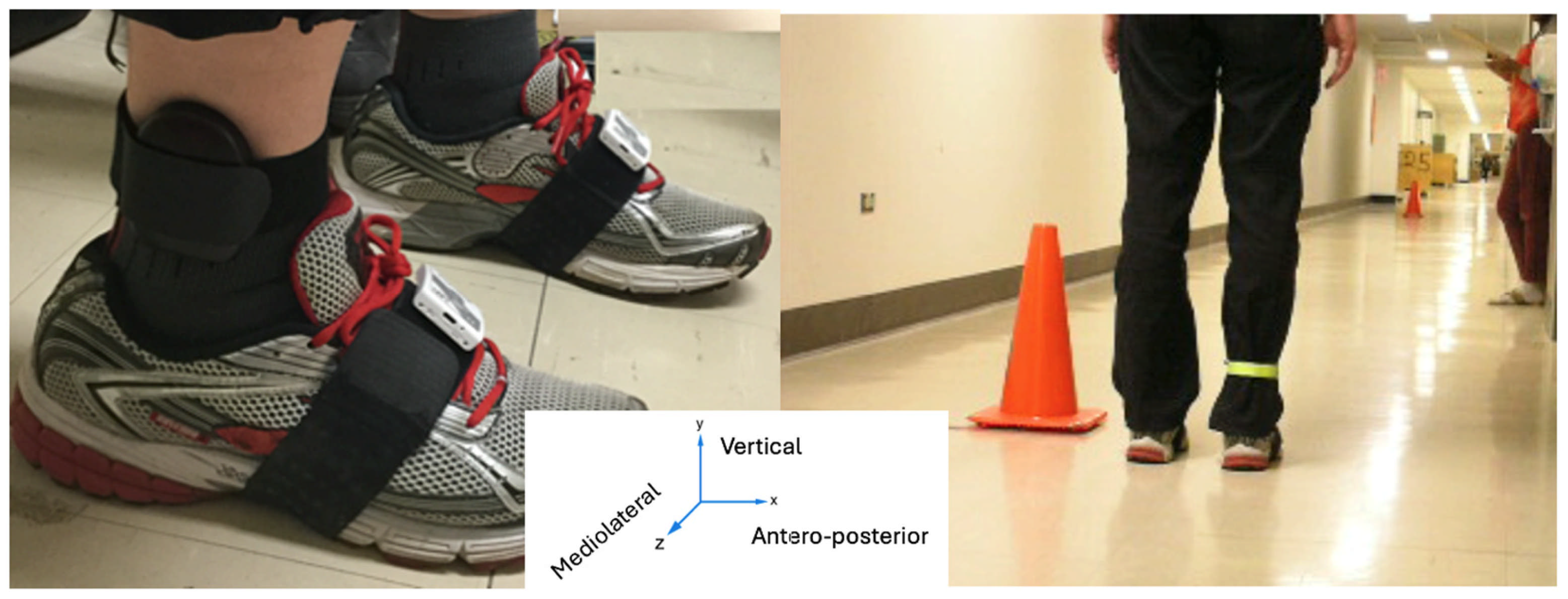
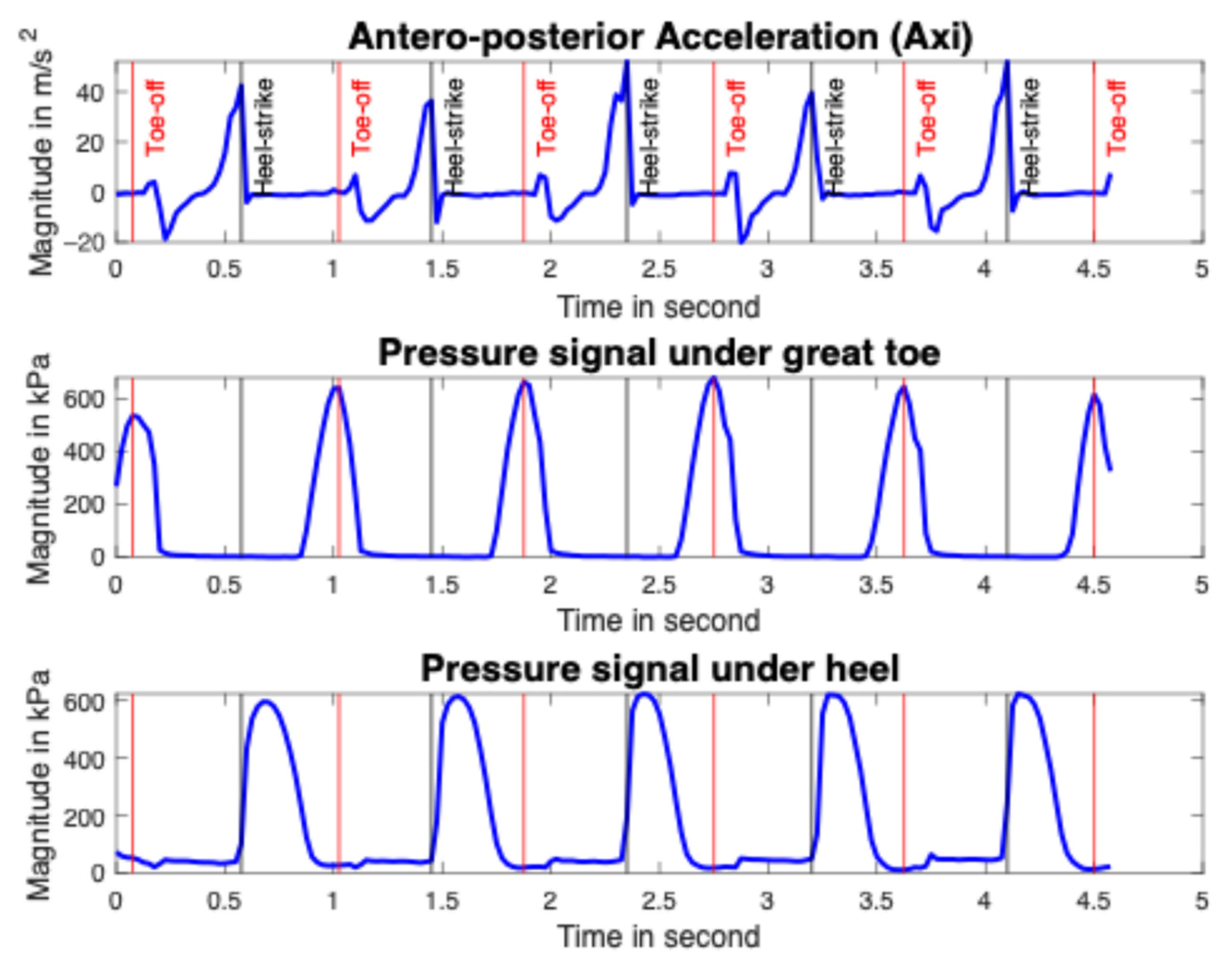
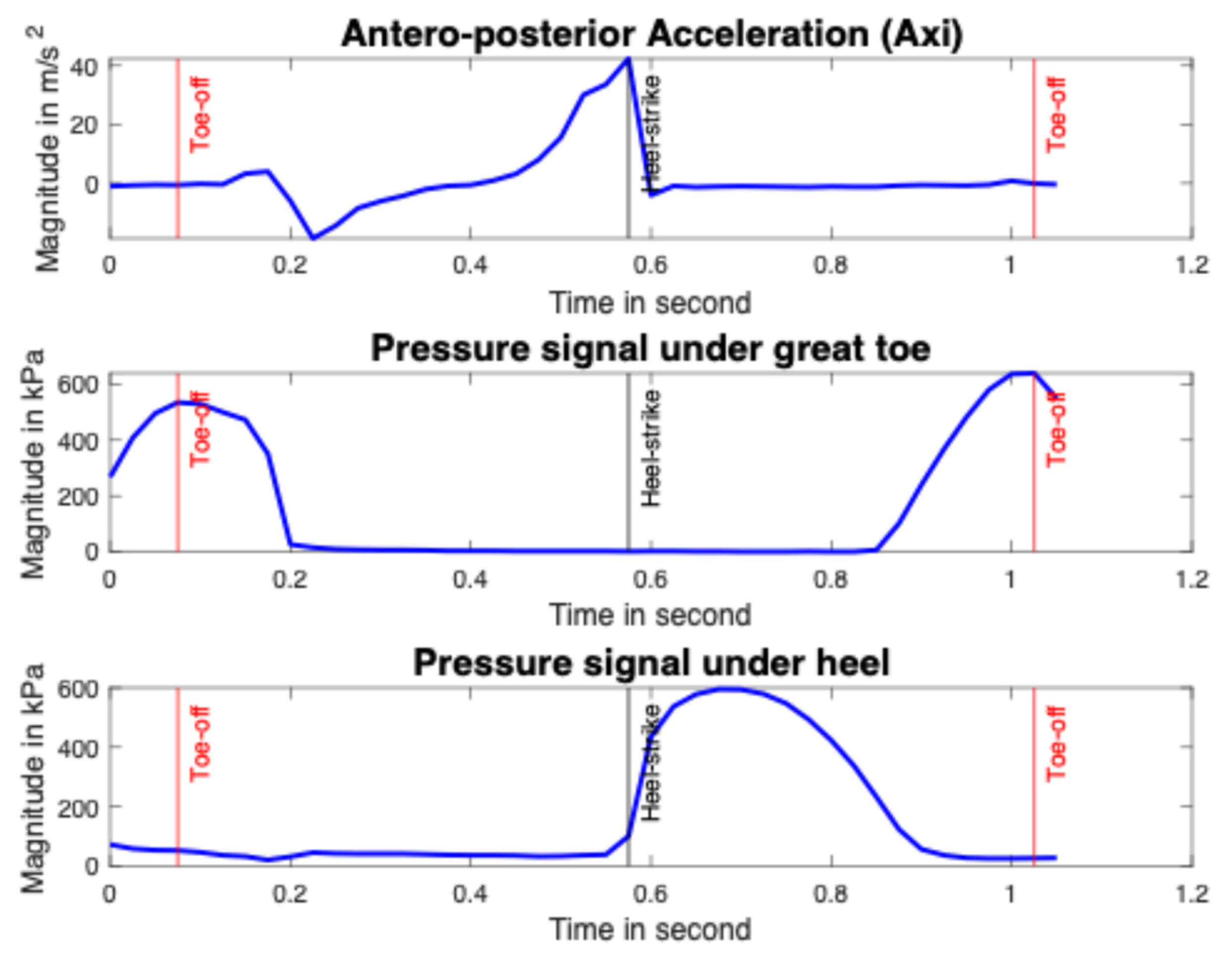
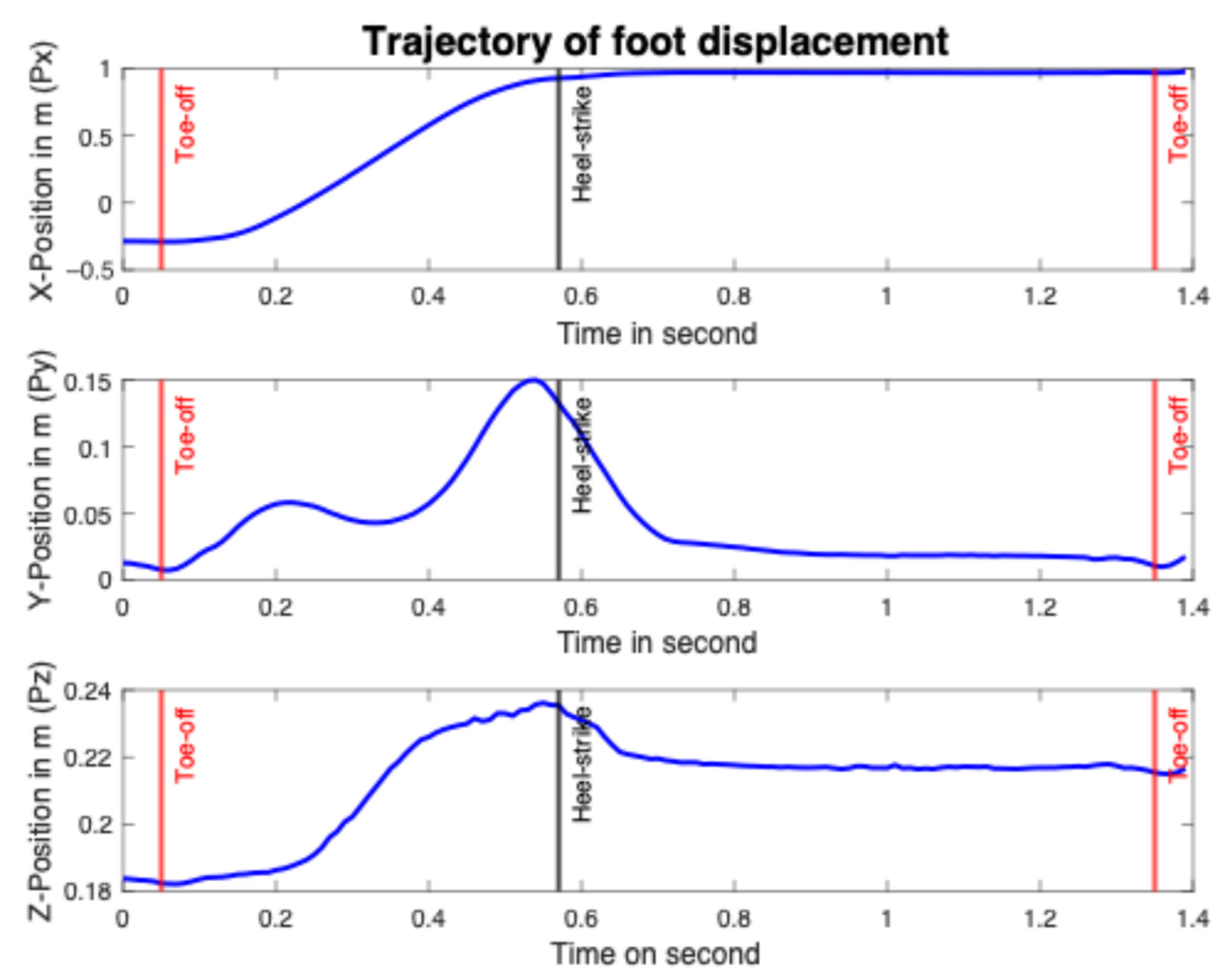
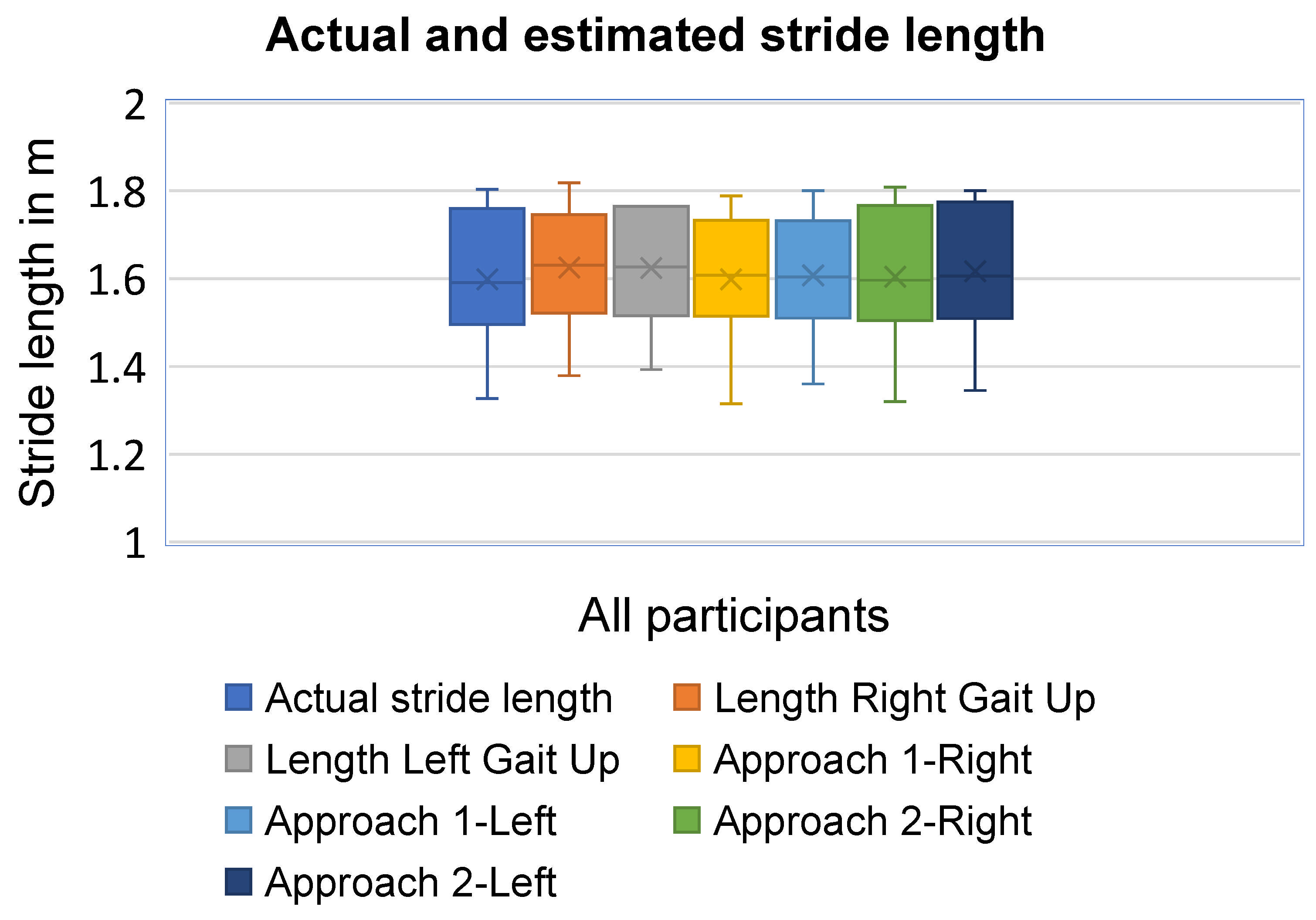
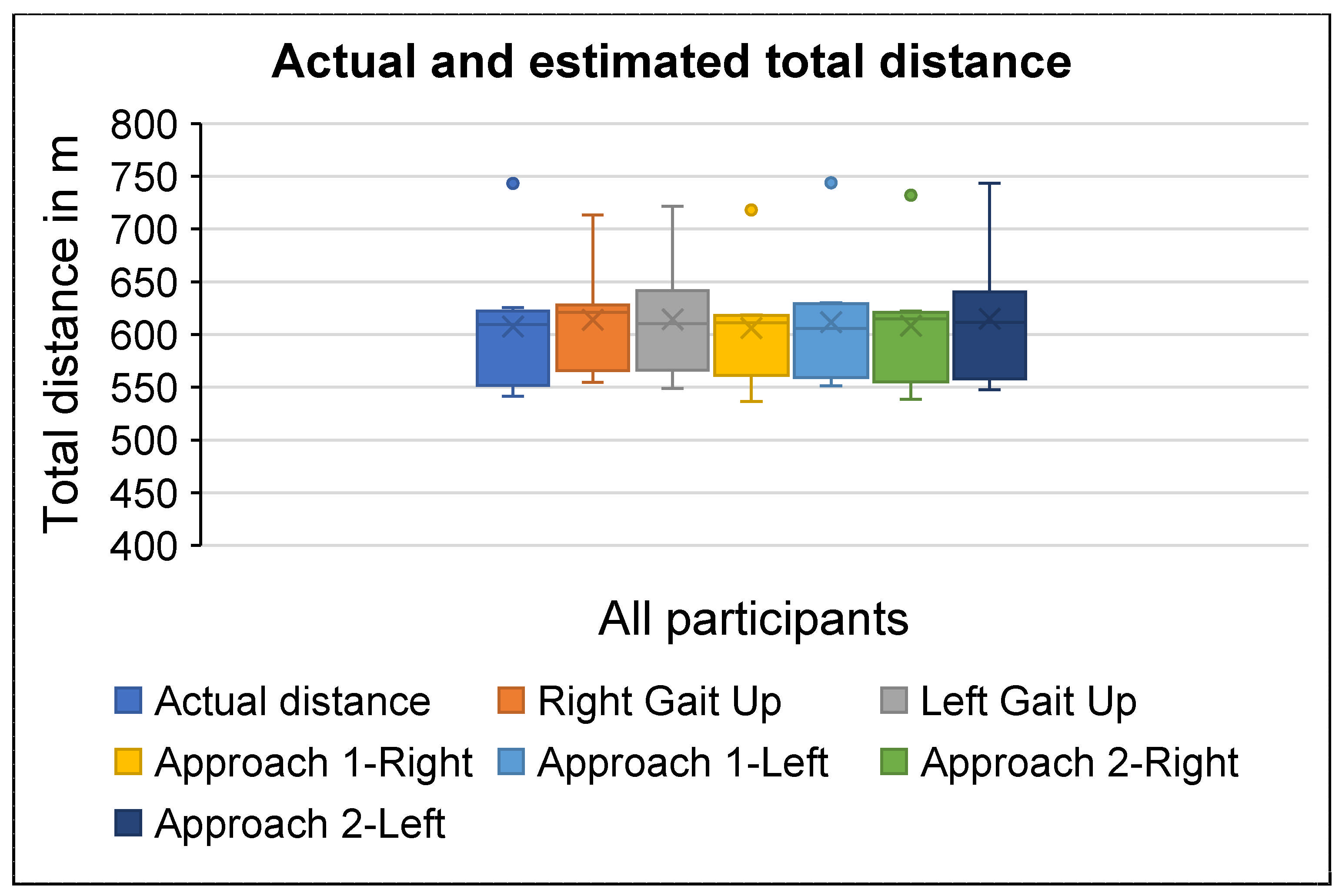
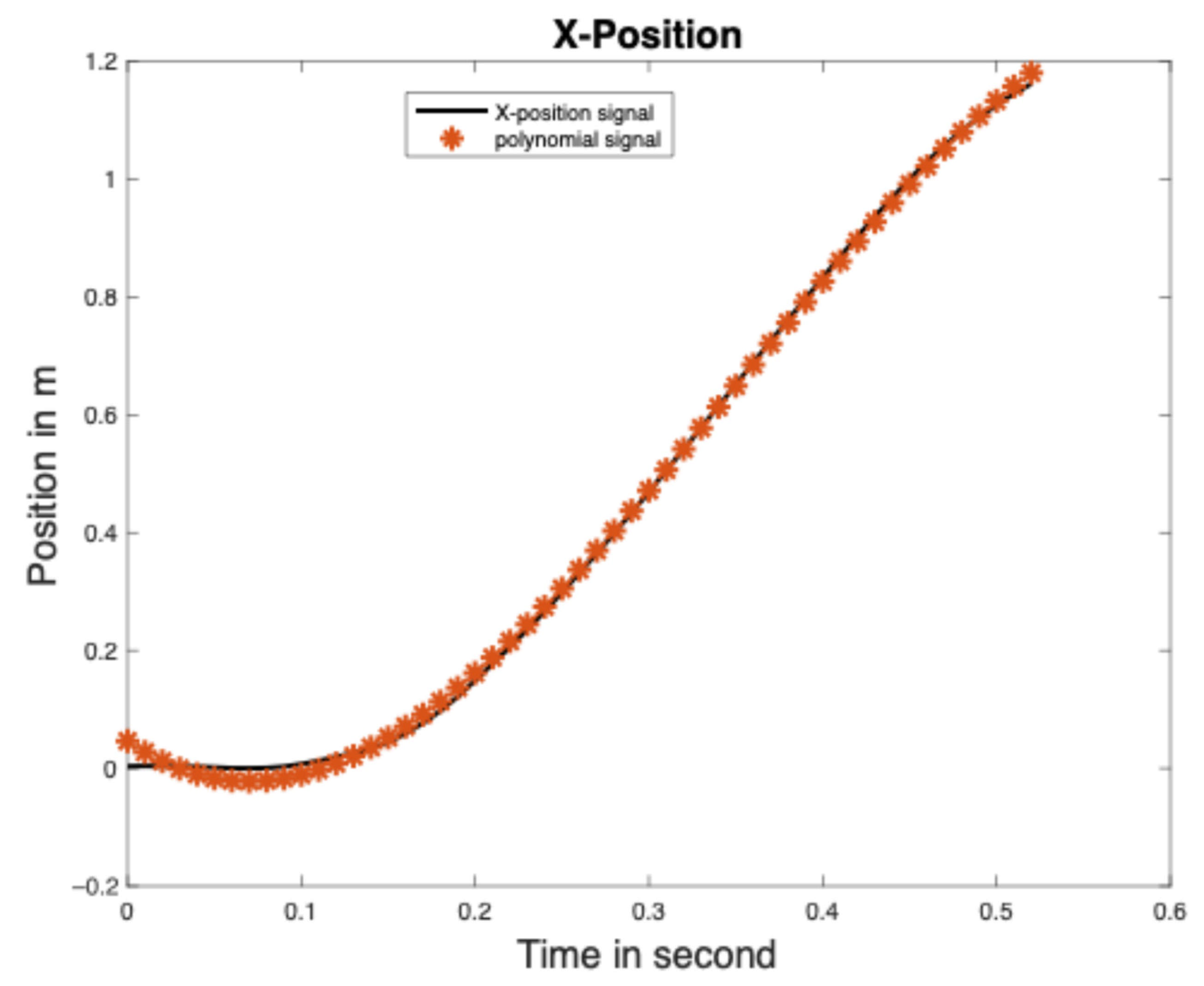
| Participants | Actual Outcomes | Gait Up | Smart Insole | |||||||||
|---|---|---|---|---|---|---|---|---|---|---|---|---|
| Number of Strides | Stride Length (m) | Number of Stride Right | Number of Stride Left | Stride Length Right (m) | Stride Length Left (m) | Number of Stride Right | Number of Stride Left | Approach 1-Stride Length Right (m) | Approach 1-Stride Length Left (m) | Approach 2-Stride Length Right (m) | Approach 2-Stride Length Left (m) | |
| P1 | 368 | 1.66 | 368 | 368 | 1.698 | 1.685 | 367 | 368 | 1.681 | 1.682 | 1.668 | 1.673 |
| P2 | 362 | 1.690 | 360 | 361 | 1.748 | 1.765 | 361 | 363 | 1.690 | 1.729 | 1.723 | 1.772 |
| P3 | 365 | 1.490 | 363 | 365 | 1.535 | 1.504 | 364 | 366 | 1.522 | 1.506 | 1.503 | 1.503 |
| P4 | 380 | 1.513 | 378 | 377 | 1.564 | 1.549 | 380 | 387 | 1.534 | 1.522 | 1.525 | 1.538 |
| P5 | 341 | 1.783 | 340 | 340 | 1.819 | 1.765 | 342 | 342 | 1.789 | 1.733 | 1.808 | 1.775 |
| P6 | 412 | 1.804 | 410 | 409 | 1.740 | 1.764 | 411 | 413 | 1.747 | 1.801 | 1.781 | 1.800 |
| P7 | 411 | 1.522 | 411 | 410 | 1.517 | 1.569 | 409 | 413 | 1.512 | 1.525 | 1.510 | 1.529 |
| P8 | 408 | 1.327 | 402 | 402 | 1.379 | 1.393 | 408 | 407 | 1.315 | 1.360 | 1.320 | 1.345 |
| Median | 374 | 1.591 | 373 | 372.5 | 1.631 | 1.627 | 373.5 | 377.5 | 1.608 | 1.604 | 1.597 | 1.606 |
| Interquartile | 49 | 0.293 | 50 | 48 | 0.231 | 0.261 | 48 | 50 | 0.235 | 0.227 | 0.278 | 0.272 |
| Stride Length Accuracies | ||||||
|---|---|---|---|---|---|---|
| Gait Up | Smart Insoles | |||||
| Participants | Right | Left | Approach 1-Right | Approach 1-Left | Approach 2-Right | Approach 2-Left |
| P1 | 97.77% | 98.56% | 98.92% | 99.64% | 98.68% | 99.04% |
| P2 | 96.57% | 95.56% | 97.40% | 97.10% | 96.86% | 96.63% |
| P3 | 96.98% | 99.06% | 97.58% | 99.33% | 97.38% | 99.13% |
| P4 | 96.63% | 97.62% | 99.41% | 98.48% | 99.21% | 98.28% |
| P5 | 97.98% | 98.99% | 98.88% | 98.99% | 98.54% | 98.49% |
| P6 | 96.45% | 97.78% | 98.23% | 99.28% | 97.84% | 99.06% |
| P7 | 99.67% | 96.91% | 97.77% | 98.42% | 97.63% | 98.23% |
| P8 | 96.08% | 95.03% | 99.02% | 99.40% | 99.25% | 99.25% |
| Median | 96.80% | 97.70% | 98.92% | 98.80% | 99.17% | 99.17% |
| Interquartile | 1.32% | 3.43% | 1.44% | 2.30% | 2.35% | 2.50% |
| Sides | For Stride Length | |||
|---|---|---|---|---|
| Intraclass Correlation Coefficient (CI) | Mann–Whitney U Test | |||
| Smart Insole | Gait Up | Smart Insole | ||
| Approach 1 | Approach 2 | Approach 1 and Approach 2 | ||
| Right | ICC = 0.993 (0.846–0.999 | ICC = 0.991 (0.726–0.999) | ICC = 0.977 (0.876–0.996) | U = 31.0 (p = 0.959) |
| Left | ICC = 0.995 (0.854–0.999) | ICC = 0.993 (0.674–0.999) | ICC = 0.987 (0.878–0.996) | U = 30.0 (p = 0.878) |
| Partici- pants (P) | Actual Distance (m) | Gait Up | Smart Insole | ||||
|---|---|---|---|---|---|---|---|
| Right | Left | Approach 1-Right | Approach 1-Left | Approach 2-Right | Approach 2-Left | ||
| P1 | 610.88 | 624.86 | 620.08 | 616.93 | 618.98 | 612.16 | 615.66 |
| P2 | 611.78 | 629.28 | 637.17 | 610.09 | 627.63 | 622.00 | 643.24 |
| P3 | 543.85 | 557.21 | 548.96 | 554.01 | 551.20 | 547.09 | 550.10 |
| P4 | 574.94 | 591.19 | 583.97 | 582.92 | 575.32 | 579.5 | 581.36 |
| P5 | 608.00 | 618.46 | 600.1 | 611.84 | 592.69 | 618.34 | 607.05 |
| P6 | 743.25 | 713.4 | 721.48 | 718.02 | 743.81 | 731.99 | 743.4 |
| P7 | 625.54 | 623.49 | 643.29 | 618.41 | 629.83 | 617.59 | 631.48 |
| P8 | 541.42 | 554.36 | 559.99 | 536.52 | 553.52 | 538.56 | 547.42 |
| Median | 609.44 | 620.97 | 610.09 | 610.96 | 605.83 | 614.87 | 611.36 |
| Interquartile | 81.69 | 66.28 | 94.33 | 64.4 | 78.63 | 70.50 | 81.38 |
| Total Distance Accuracies | ||||||
|---|---|---|---|---|---|---|
| Gait Up | Smart Insoles | |||||
| Participants | Right | Left | Approach 1-Right | Approach 1-Left | Approach 2-Right | Approach 2-Left |
| P1 | 97.71% | 98.49% | 99.01% | 98.67% | 99.79% | 99.22% |
| P2 | 97.14% | 95.85% | 99.72% | 97.41% | 98.33% | 94.86% |
| P3 | 97.54% | 99.06% | 98.13% | 98.65% | 99.40% | 98.85% |
| P4 | 97.17% | 98.43% | 98.61% | 99.93% | 99.21% | 98.88% |
| P5 | 98.28% | 98.70% | 99.37% | 97.48% | 98.30% | 99.84% |
| P6 | 95.98% | 97.07% | 96.61% | 99.92% | 98.49% | 99.98% |
| P7 | 99.67% | 97.16% | 98.86% | 99.32% | 98.73% | 99.05% |
| P8 | 97.61% | 96.57% | 99.10% | 97.76% | 99.47% | 98.89% |
| Median | 97.58% | 97.80% | 98.93% | 98.66% | 98.97% | 99.97% |
| Interquartile | 1.14% | 2,13% | 1.24% | 2.44% | 0.18% | 0.14% |
| Sides | Total Distance Covered | |||||
|---|---|---|---|---|---|---|
| Intraclass Correlation Coefficient (CI) | Mann–Whitney U Test | |||||
| Smart Insole | Gait Up | Smart Insole | Gait Up | |||
| Approach 1 | Approach 2 | Approach 1 | Approach 2 | |||
| Right | ICC = 0.992 (0.959–0.998) | ICC = 0.996 (0.982–0.999) | ICC = 0.980 (0.908–0.996 | U = 31.0; p = 0.959 | U = 28.0; p = 0.721 | U = 25.0; p = 0.505 |
| Left | ICC = 0.994 (0.972–0.999) | ICC = 0.991 (0.941–0.998) | ICC = 0.982 (0.917–0.996) | U = 26.0; p = 0.574 | U = 26.5; p = 0.599 | U = 27.0; p = 0.645 |
| Author | Approaches | Results |
|---|---|---|
| Bennett et al. [18] | Modeling human leg as a two-link revolute robot, then using extended Kalman filter (EKF) to estimate the displacement in a straight line | Accuracy of 97% on linear displacement |
| Meng et al. [19] | Self-contained pedestrian tracking approach using a foot-mounted inertial and magnetic sensor module with traditional zero velocity updates and stride information to further correct the acceleration double integration drifts | For short distance: position error of 0.44 ± 0.20 m on straight line of 10 m and 15 m, 0.45 ± 0.08 m on 180° turn, and 0.40 ± 0.07 m on circle of radius 3 m For long distance of 3 min indoor walking, position error of 4.33 ± 1.77 m and 3.88 ± 0.35 m for 6 min outdoor walking |
| Miyazaki et al. [27] | Simplified two-segment leg model and implemented a stride length estimation algorithm based on a single gyroscope | Relative estimation error of 15% |
| Kim et al. [29] | Analyzing the relationship between stride, step period, and acceleration. | Calculated accuracies of 96.59% (error: 3.40%) for 1st test and 95.83 (error: 4.17%) for 2nd test |
| Xia et al. [31] | A non-linear step length estimation model based on statistics proposed by [30] where Step = k·4√αz − max − αz–min | Not reported |
| Aminian et al. [70] | Stride length estimation using sensor units at thigh and shank in combination with a double-inverted pendulum model | Root mean square error (RMSE) of 7.2% (0.07 m) |
| Zijlstra et al. [73] | Inverted pendulum to model the center of mass (CoM) trajectory | 86% to 94% of accuracy for stride length |
| Zijlstra et al. [34] | Empirical approximation of the geometric model to estimate the stride length due to changes of vertical displacement of the CoM | Underestimation of stride length for all participants |
| Gonzalez et al. [71] | Model by extracting additional features from the acceleration signal to further improve the step length estimation | Stride length error of 16% |
| Lueken et al. [72] | Model of the inverted pendulum and idea of double integration of the antero–posterior acceleration | Stride length error from 8.52% to 12.87% |
| Lueken et al. [72] | Kalman filter and idea of double integration of the antero–posterior acceleration | Stride length error from 7.95% to 15.00% |
| Zrenner et al. [10] | Parametric regression model based on acceleration | Stride length error 7.9% |
| Ziagskas et al. [13] | Artificial intelligence algorithms | ICC = 0.939 for left side and ICC = 0.939 for right side |
| Our Approach 1 | Model based on director coefficients of acceleration data | For stride length, right: 98.92% (error: 1.08%) and left: 98.80% (error: 1.20%) For total distance, right: 98.9 (3.10)% (error: 1.08%) and left: 98.69 (2.50%) (error: 1.31%) |
| Our Approach 2 | Model based on the dynamic time warping | For stride length, right: 99.17% (error: 0.83%) and left: 98.17% (error: 0.83%) For total distance, right: 98.95 (0.10)% (error: 1.05%) and left: 99.03 (5.10)% (error: 0.97%) |
Disclaimer/Publisher’s Note: The statements, opinions and data contained in all publications are solely those of the individual author(s) and contributor(s) and not of MDPI and/or the editor(s). MDPI and/or the editor(s) disclaim responsibility for any injury to people or property resulting from any ideas, methods, instructions or products referred to in the content. |
© 2025 by the authors. Licensee MDPI, Basel, Switzerland. This article is an open access article distributed under the terms and conditions of the Creative Commons Attribution (CC BY) license (https://creativecommons.org/licenses/by/4.0/).
Share and Cite
Ngueleu, A.-M.; Otis, M.J.-D.; Batcho, C.S. Validation of Novel Stride Length Model-Based Approaches to Estimate Distance Covered Based on Acceleration and Pressure Data During Walking. Sensors 2025, 25, 6217. https://doi.org/10.3390/s25196217
Ngueleu A-M, Otis MJ-D, Batcho CS. Validation of Novel Stride Length Model-Based Approaches to Estimate Distance Covered Based on Acceleration and Pressure Data During Walking. Sensors. 2025; 25(19):6217. https://doi.org/10.3390/s25196217
Chicago/Turabian StyleNgueleu, Armelle-Myriane, Martin J.-D. Otis, and Charles Sebiyo Batcho. 2025. "Validation of Novel Stride Length Model-Based Approaches to Estimate Distance Covered Based on Acceleration and Pressure Data During Walking" Sensors 25, no. 19: 6217. https://doi.org/10.3390/s25196217
APA StyleNgueleu, A.-M., Otis, M. J.-D., & Batcho, C. S. (2025). Validation of Novel Stride Length Model-Based Approaches to Estimate Distance Covered Based on Acceleration and Pressure Data During Walking. Sensors, 25(19), 6217. https://doi.org/10.3390/s25196217








